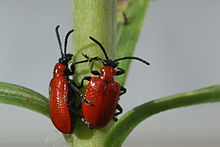Lily Beetle Spotting & Prevention

What has got 6 legs, a head, 2 eyes and red wings and is not a dice game of Beetle. It is the red lily beetle Lilioceris lilii that consumes large quantities of one of our favorite plants.
How to Spot Lily Beetle
- Adults are 8mm long, bright red with a black head and legs.
- Eggs are 1mm long and orange-red, found in groups on the underside of lily leaves and they hatch in around a week.
- Larvae have orange bodies with black heads but are normally covered with their own slimy black excrement.
- The fully grown larvae are 8-10mm long.
- At the pupal stage they lie in the soil.
- Both the adults and larvae can defoliate lilies and fritillaries in short order.
- Leaves get ragged and black gungy deposits can be seen on infected plants.
- The red beetles easily fall off leaves and hide in the soil when gardeners try to remove them by hand.
- The beetle was initially confined to south east England but has spread north.
The Lily Beetle Cycle
- Adult lily beetles emerge from the soil from late March to May and feed on foliage between May and September.
- Adults feed and lay eggs on the underside of leaves of host plants from late April until early September.
- After about two weeks, when the larvae are fully grown, they pupate in the soil. Two to three weeks later new adults emerge.
- The beetles overwinter as adults in sheltered places, often in the soil but not necessarily near lilies.
- This non-native pest became established just before the second world war.
Prevention, Predators and Parasites
- Red lily beetle overwinters in soil, leaf litter and other sheltered places so good husbandry can help.
- Small infestations can be picked off by hand. There is some pleasure in squashing a red beetle that has caused your plant so much damage.
- There are some parasitic wasps but probably not enough to help your lilies survive.
- The RHS to which I am indebted for this advice say ‘ Pesticides are likely to be more effective on larvae than adults
- Heavy infestations which are impractical to remove by hand can be treated with pesticides
- Organic insecticides containing natural pyrethrins Several application of these short persistence products may be necessary to give good control
- Synthetic pyrethroid pesticides such as lambda-cyhalothrin (e.g. Westland Resolva Bug Killer), or deltamethrin (e.g. Sprayday Greenfly Killer) can be used
- The systemic neonicotinoid insecticide acetamiprid (e.g. Bug Clear Ultra) can also be used’
- In my experience it is wise not to expect miracles with chemical treatments and beware they can kill pollinating insects.